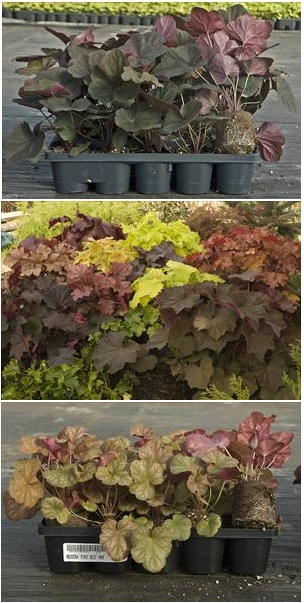info@bloomindesigns.com
Shop by Category
Shop by Brand
Shop by Brand
Heuchera
Vibrant Foliage & Easy-Care Color
Heuchera, also known as Coral Bells, are a fantastic addition to any garden for a multitude of reasons:
- Unmatched Foliage Color: Heuchera are primarily grown for their spectacular and diverse foliage. They come in a stunning array of colors, including shades of purple, red, bronze, silver, green, and even bicolors. This allows you to create captivating visual interest and contrast in your garden beds, borders, and containers.
- Year-Round Interest: Unlike many flowering plants, Heuchera offer beauty throughout the entire growing season. Their foliage maintains its color and vibrancy from spring through fall, and some varieties even retain their color during mild winters.
- Versatile Planting Options: Heuchera are adaptable and can thrive in various garden settings. They look fantastic in mass plantings, as edging along pathways, in rock gardens, woodland gardens, and even in mixed containers.
- Attracts Pollinators: While their flowers are delicate and not the main attraction, they do produce airy spikes of small bell-shaped blooms that attract hummingbirds and other beneficial pollinators.
- Low Maintenance: Once established, Heuchera are relatively low-maintenance plants. They are generally pest and disease resistant and don't require frequent watering or fertilization.
- Shade Tolerance: While many varieties prefer partial shade, there are Heuchera that can tolerate full sun (especially in cooler climates) and others that thrive in deeper shade, making them a versatile choice for different light conditions in your garden.
Location:
- Light: Most Heuchera prefer partial shade (4-6 hours of dappled sunlight or morning sun and afternoon shade). Some varieties can tolerate more sun, especially those with lighter-colored foliage. Check the specific variety's requirements. In hotter climates, providing afternoon shade is generally beneficial.
- Soil: Heuchera thrive in well-draining soil that is rich in organic matter. Heavy clay soil can lead to root rot, so amend it with compost or other organic material before planting.
- Spacing: Space your Heuchera plants according to their mature size, typically 12-18 inches apart. This allows for good air circulation and prevents overcrowding.
Planting
- Timing: The best time to plant Heuchera is in the spring or fall when the weather is mild.
- Dig the Hole: Dig a hole that is twice as wide and just as deep as the plant's root ball.
- Prepare the Plant: Gently remove the Heuchera from its container and loosen any circling roots.
- Planting: Place the plant in the center of the hole, ensuring that the crown (where the stems meet the roots) is at or slightly above the soil level. Planting too deep can cause rot.
- Backfill: Fill the hole with the amended soil, gently firming it around the base of the plant.
- Water Thoroughly: Water the newly planted Heuchera deeply to settle the soil and help the roots establish.
Growing and Caring:
- Watering: Water regularly, especially during dry periods, until the plants are established. Once established, Heuchera are relatively drought-tolerant. Avoid overwatering, as this can lead to root rot. Water at the base of the plant to keep the foliage dry.
- Mulching: Apply a layer of organic mulch (such as shredded bark or compost) around the base of the plants to help retain moisture, suppress weeds, and regulate soil temperature. Keep the mulch away from the crown of the plant.
- Fertilizing: Heuchera are not heavy feeders. A light application of balanced liquid fertilizer in the spring is usually sufficient. Avoid over-fertilizing, which can result in leggy growth and reduced foliage color.
- Deadheading: Remove spent flower stalks to encourage more blooms and maintain a tidy appearance.
- Division: Over time, Heuchera can become crowded. Divide mature plants every 3-4 years in the spring or fall to rejuvenate them and create more plants. Gently dig up the clump, divide it into smaller sections with healthy roots and foliage, and replant them.
- Winter Care: In colder climates, some Heuchera may benefit from a light winter mulch of evergreen boughs or straw to protect them from harsh conditions and prevent heaving (when the freeze-thaw cycle pushes plants out of the ground). In Milton, Georgia, winter protection is generally not necessary.
- Pest and Disease Control: Heuchera are generally resistant to pests and diseases. However, watch out for occasional issues like slugs, snails, or powdery mildew. Address any problems promptly with appropriate organic pest control methods or fungicides.
By following these guidelines, you can enjoy the vibrant beauty and easy care of Heuchera plants in your garden for years to come!

Heuchera, more affectionately known as coral bells or alumroot, is a fantastically versatile and colorful perennial that is native to North America. Here is a rundown of what makes this plant special:
Key Features:
- Stunning Foliage: Heuchera is primarily grown for its incredibly diverse and colorful foliage. Expect a wide array of colors, including amber, burgundy, butterscotch, bronze, green, gold, purple, silver, and yellow. Many varieties also have unique variegation patterns.
- Delicate Blooms: While the foliage is the main attraction, Heuchera also produces small, bell-shaped flowers on tall, wiry stems. These blooms, often in shades of coral (hence the name!), add a charming touch.
- Adaptable Growth: These perennials are relatively easy to grow and tolerate a range of conditions. They do best in partial shade with well-drained soil, but many can handle full sun in cooler climates.
- Variety of Uses: Heuchera's mounding habit makes it ideal for borders, edging, rock gardens, and container planting.
Why Gardeners Love Heuchera:
- Low Maintenance: Once established, Heuchera requires minimal care.
- Long-lasting Color: Their colorful foliage provides interest throughout the growing season.
- Attracts Pollinators: The flowers attract hummingbirds and butterflies.
- Deer Resistant: Heuchera is generally unappealing to deer.
- Cold Hardy: Many varieties are hardy in USDA zones 4-9, tolerating a wide range of temperatures.
If you are looking for a plant that provides long-lasting color, texture, and versatility in the garden, Heuchera is an excellent choice!
